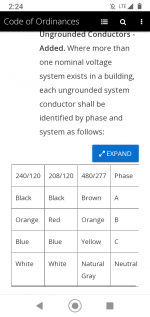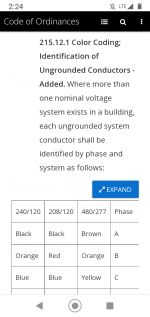You are using an out of date browser. It may not display this or other websites correctly.
You should upgrade or use an alternative browser.
You should upgrade or use an alternative browser.
Looking for code requiring 3 different colors for 3 different phases
- Thread starter Knipex Dream
- Start date
- Status
- Not open for further replies.
Knipex Dream
Member
- Location
- Connecticut
What Roger posted is probably the most common method you will see. It is not the only method. As been mentioned many times code only says you need to distinguish system and phase, it doesn't give any indication or requirement of how you do that.
Knipex Dream
Member
- Location
- Connecticut
If the signage reads phase A-L1,
phase B-L2, phase C-L3 that is distinguishing phase of each. The conductors are identified by their designated termination point. If they are switched to reverse direction on a color identified set must the color be re-identified at the load and all splice points so the color of C phase is indeed C everywhere to be truly code compliant?
I apologize if my rebuttals are bothering anyone but I do want to know the factual answers to this.
phase B-L2, phase C-L3 that is distinguishing phase of each. The conductors are identified by their designated termination point. If they are switched to reverse direction on a color identified set must the color be re-identified at the load and all splice points so the color of C phase is indeed C everywhere to be truly code compliant?
I apologize if my rebuttals are bothering anyone but I do want to know the factual answers to this.
kwired
Electron manager
- Location
- NE Nebraska
- Occupation
- EC
To some extent I do agree that conductors are generally identified by their designated termination point. But If we look into that one real hard there should be no need to identify grounded or equipment grounding conductors with white, gray, green either, their designated termination point should be sufficient.If the signage reads phase A-L1,
phase B-L2, phase C-L3 that is distinguishing phase of each. The conductors are identified by their designated termination point. If they are switched to reverse direction on a color identified set must the color be re-identified at the load and all splice points so the color of C phase is indeed C everywhere to be truly code compliant?
I apologize if my rebuttals are bothering anyone but I do want to know the factual answers to this.
Yes, and it is covered in 210.5(C)(1)If the signage reads phase A-L1,
phase B-L2, phase C-L3 that is distinguishing phase of each. The conductors are identified by their designated termination point. If they are switched to reverse direction on a color identified set must the color be re-identified at the load and all splice points so the color of C phase is indeed C everywhere to be truly code compliant?
1) Branch Circuits Supplied from Mor e Than One Nominal
Voltage System. Where the premises wiring system has
branch circuits supplied from more than one nominal voltage
system, each ungrounded conductor of a branch circuit shall
be identified by phase or line and system at all termination,
connection, and splice points in compliance with 210.5(C)(1)
(a) and (b).
Roger
kwired
Electron manager
- Location
- NE Nebraska
- Occupation
- EC
??Yes.
Roger
Maybe I'm not quite following you, but how does changing rotation somewhere in middle of the run maintain identification of line or phase? If "A phase" is brown at the origin then conductor with same potential at load end should be brown regardless which terminal it is landed on at the load equipment.
Ohhh, now I see what he was asking and agree with you.The motor connections have no relevance to the premise wire system identification. Motor terminals do not have to be L1, L2, L3 so what connects to each terminal or wire doesn't matter.??
Maybe I'm not quite following you, but how does changing rotation somewhere in middle of the run maintain identification of line or phase? If "A phase" is brown at the origin then conductor with same potential at load end should be brown regardless which terminal it is landed on at the load equipment.
Roger
GeorgeB
ElectroHydraulics engineer (retired)
- Location
- Greenville SC
- Occupation
- Retired
and that's a single voltage system; you changed what was used on 400/3/50. This side of the pond has 208, 480, and 600.Perhaps just for interest we invariably used RYB for three phase. It was simple. Not now.. Brown, black, and grey. Stupid in my opinion and many agree with that.
When motors get large, say 500-5000kW, what voltage do you use; here, "2300", "4160", and "7200" come to mind.
Mostly we use 400V.and that's a single voltage system; you changed what was used on 400/3/50. This side of the pond has 208, 480, and 600.
When motors get large, say 500-5000kW, what voltage do you use; here, "2300", "4160", and "7200" come to mind.
Beyond that we quite often 690V, 3.3kV, and 11kV. That's common for the UL. Other countries I have been to ised 13.6kW 60 Hz
Mr. Serious
Senior Member
- Location
- Oklahoma, USA
- Occupation
- Electrical Contractor
In India and Thailand they still use red/yellow/blue.Perhaps just for interest we invariably used RYB for three phase. It was simple. Not now.. Brown, black, and grey. Stupid in my opinion and many agree with that.
A commercial job site here in Oklahoma, USA had some new air conditioning equipment that used reddish-pink/yellow/blue. It must have been built in India or something. Not being familiar with the color code in that part of the world, I hooked it up with A and B phases swapped, and we had to change it.
When did this change happen? Are the color codes legally mandated or can you use alternate ones? I remember hearing they did a study and found brown and blue are the most easily distinguished colors?Perhaps just for interest we invariably used RYB for three phase. It was simple. Not now.. Brown, black, and grey. Stupid in my opinion and many agree with that.
Here the only ones mandated are the Neutral and Equipment grounding conductor and both of those have options.
I dont think thats the intent of the code, and the AHJ here would not allow me to use the terminations to identify the conductor.The conductors are identified by their designated termination point.
Plus not all equipment has the terminations labeled L1 L2 L3 etc.
I would need colored wire, tags or labels etc on the actual conductors.
I could use a wrap around label L1 L2 L3 etc
What about two wire circuits? Do you all try to stay with phase color coding to something like a 208V single phase load? 120V load?
Yes, the colours are mandated. For wires for in enclosures we almost always used 1.0mm2 mostly black and all the ferrules were all numbered. That was our practice.When did this change happen? Are the color codes legally mandated or can you use alternate ones? I remember hearing they did a study and found brown and blue are the most easily distinguished colors?
Here the only ones mandated are the Neutral and Equipment grounding conductor and both of those have options.
I dont think thats the intent of the code, and the AHJ here would not allow me to use the terminations to identify the conductor.
Plus not all equipment has the terminations labeled L1 L2 L3 etc.
I would need colored wire, tags or labels etc on the actual conductors.
I could use a wrap around label L1 L2 L3 etc
What about two wire circuits? Do you all try to stay with phase color coding to something like a 208V single phase load? 120V load?

kwired
Electron manager
- Location
- NE Nebraska
- Occupation
- EC
408.3(E)(1) does however does have bus arrangement requirements A B C front to back, top to bottom or left to right when facing from front of the gear. That doesn't really carry over to other equipment though is pretty common to still follow that in many instances.When did this change happen? Are the color codes legally mandated or can you use alternate ones? I remember hearing they did a study and found brown and blue are the most easily distinguished colors?
Here the only ones mandated are the Neutral and Equipment grounding conductor and both of those have options.
I dont think thats the intent of the code, and the AHJ here would not allow me to use the terminations to identify the conductor.
Plus not all equipment has the terminations labeled L1 L2 L3 etc.
I would need colored wire, tags or labels etc on the actual conductors.
I could use a wrap around label L1 L2 L3 etc
What about two wire circuits? Do you all try to stay with phase color coding to something like a 208V single phase load? 120V load?
Remember municipalitys can and do have additional standards. Chicago would like to see brown,orange,yellow cable for their 480 volt services. It may not be in the NEC but may be written in municipal code additions. You may have to check when pulling your permit.What code, if any, requires different phases to be different colors? 210.5(C)1 and 215.12(C) dictate that different voltage systems must be differentiated. But, nothing I can find prohibits for example if 3 black wires are used for a 3 phase 480v circuit.
Tulsa Electrician
Senior Member
- Location
- Tulsa
- Occupation
- Electrician
"What code, if any, requires different phases to be different colors?"
In most case the local AHJ has some sort of amendment that states color coding rules.
I bring up AHJ due the fact the way you ask your question.
In most case the local AHJ has some sort of amendment that states color coding rules.
I bring up AHJ due the fact the way you ask your question.
Attachments
JEFF MILLAR
Senior Member
The NEC requires colour code for Neutral and ground. Phase conductor colour codes are typically called for in the project design specifications. And for different voltage levels. This is not an NEC requirement.
kwired
Electron manager
- Location
- NE Nebraska
- Occupation
- EC
Those local AHJ's that do this or any other rule not in the NEC really should have such rules "on the record" someplace, typically called an amendment to the NEC. Some do, some don't.Remember municipalitys can and do have additional standards. Chicago would like to see brown,orange,yellow cable for their 480 volt services. It may not be in the NEC but may be written in municipal code additions. You may have to check when pulling your permit.
If only thing they legally adopted is NEC with no amendments, they are in the wrong enforcing something that is not in there.
kwired
Electron manager
- Location
- NE Nebraska
- Occupation
- EC
And for anyone that did not look that up, it is for a particular circumstance and only in health care facilities.To give the OP an accurate answer the NEC does require Orange Brown Yellow for a system, see 517.160. In 2011 a requirement for a stripe to be on each conductor was added.
Roger
There is no general rule for such color coding in the NEC.
- Status
- Not open for further replies.



